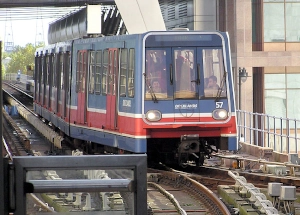The Docklands Light Railway (DLR) is London’s innovative driverless train system connecting East London’s key destinations. Whether you’re heading to Canary Wharf for business, exploring Greenwich’s maritime history, or catching a flight from London City Airport, the DLR offers a quick and scenic way to travel across zones 1-3.
The DLR is an automated light railway system operated by Transport for London (TfL). Opened in 1987, it was designed to regenerate the former docklands area and now serves as a vital transport link for both commuters and visitors.
Unlike traditional Underground trains, the DLR runs above ground for most of its route, offering panoramic views of East London’s evolving skyline. The system is completely driverless, though train captains are present on board for safety and assistance.

The DLR network consists of six main branches radiating from central interchange points. Understanding the route structure helps you navigate efficiently.
Bank to Lewisham: Connects the City of London with Southeast London, passing through Canary Wharf and Greenwich.
Tower Gateway to Beckton: Serves the Royal Docks area and London City Airport via a connection at Canning Town.
Stratford to Canary Wharf/Lewisham: Links the Olympic Park area with major business and leisure districts.
Bank/Tower Gateway to Woolwich Arsenal: The newest extension, crossing under the Thames to reach Woolwich.
The DLR serves 45 stations across East London, each providing step-free access from street to platform. All stations feature tactile paving, visual displays, and audio announcements.
Canary Wharf: London’s secondary financial district with shopping centres and restaurants.
Greenwich: Access to the Royal Observatory, Cutty Sark, and National Maritime Museum.
Island Gardens: Perfect viewpoint of Greenwich across the Thames, plus access to the foot tunnel.
London City Airport: Direct connection for domestic and European flights.
West India Quay: Gateway to the Museum of London Docklands.
Royal Victoria: Near the Emirates Air Line cable car and ExCeL London.
Stratford: Gateway to Queen Elizabeth Olympic Park and Westfield shopping centre.
The DLR is an excellent choice for families exploring London. The driverless trains fascinate children, the step-free access makes life easier with pushchairs, and the generous free travel policy helps keep costs down.
The DLR uses London’s standard Oyster and contactless payment system, but families benefit from particularly good value:
Simply touch in and out with your Oyster or contactless card at the yellow readers. Children travelling free don’t need to touch in, but they must be accompanied by an adult with a valid ticket.
The DLR is designed with families in mind:
What makes the DLR particularly suited for families:
The DLR runs seven days a week with high frequency during peak times.
Monday to Saturday: 05:30 – 00:30
Sunday: 07:00 – 23:30
Note: Timetables may vary by station and route. For updated schedules, service alerts, and route planning, visit the official Transport for London DLR page.
Service frequency may vary during major events or maintenance. Always check official sources for real-time updates before travelling.
The DLR provides excellent access to some of London’s most interesting areas, many overlooked by typical tourist routes.
Visit the Prime Meridian at the Royal Observatory, explore the historic Cutty Sark clipper ship, and enjoy Greenwich Market’s food and crafts. The area is a UNESCO World Heritage Site.
London’s modern business district features impressive skyscrapers, underground shopping malls, waterside dining, and public art installations. The area is particularly striking when illuminated at night.
This free museum tells the story of London’s river, port, and people from Roman times through to the regeneration of the Docklands.
Take the cable car across the Thames for panoramic views of East London, the O2 Arena, and the Thames Barrier.
Explore the venues from London 2012, including the London Stadium, velodrome, and aquatics centre. The park offers walking trails, playgrounds, and seasonal events.
Sit at the front: With no driver’s cab, the front window offers unobstructed views of the track ahead—a unique London experience.
Avoid peak times: If possible, travel outside rush hours (before 06:30 or after 09:30 in the morning) for a more comfortable journey.
Use contactless payment: It’s often cheaper than buying day tickets and automatically caps your daily spending.
Download the TfL Go app: Real-time updates, journey planning, and service status at your fingertips.
Mind the gaps at Bank: Some older stations have slight platform gaps—watch your step when boarding.
Explore on weekends: The DLR is quieter on Saturdays and Sundays, making it ideal for sightseeing.
Whilst both are part of the TfL network, the DLR differs from the Underground in several ways:
Despite these differences, the DLR integrates seamlessly with the Underground, Overground, and national rail services.
For tourists visiting East London, the DLR is not just practical—it’s an experience in itself. The elevated views, modern design, and access to lesser-known attractions make it a highlight of London’s transport network.
Whether you’re interested in maritime history, modern architecture, Olympic legacy, or simply want to see a different side of London, the DLR gets you there efficiently whilst offering a memorable journey.
Planning your journey? Download a printable DLR map along with other useful London transport guides from our Travel Downloads page. Perfect for offline reference when exploring the city.